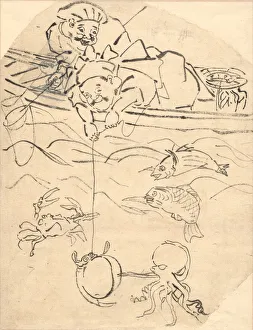Daikoku Collection
Daikoku: The Symbol of Fortune and Prosperity in Japanese Art Throughout history, the figure has been depicted in various forms
All Professionally Made to Order for Quick Shipping
Daikoku: The Symbol of Fortune and Prosperity in Japanese Art Throughout history, the figure has been depicted in various forms, showcasing his significance as a symbol of good fortune and prosperity in Japanese culture. In one captivating artwork titled "A Court Lady as Daikoku, " created by Katsukawa Shuntei around 1820, we see the intriguing fusion of femininity with the deity's attributes. Another remarkable piece is "Egoyomi Daikoku" from 1864 by Choshuntei Naokage. This artwork portrays Daikoku balancing rice bales, a mallet, and even a rooster on his feet – an impressive display that represents abundance and fertility. In Hokusai's work from 1797 titled "The Gods of Fortune Ebisu and Daikoku, " we witness the harmonious presence of these two deities associated with wealth and luck. Their depiction showcases their importance within Japanese folklore. Isoda Koryusai's creation called "Sugawara of the Tsuruya dreaming of Daikoku" dates back to approximately 1778. It depicts Sugawara no Michizane, a renowned scholar who dreams about encountering Daikoku – perhaps seeking guidance or blessings for his endeavors. Moving away from artistry focused solely on deities, there are depictions such as "Traffic and pedestrians on the Daikoku bridge" capturing everyday life scenes in Osaka during different periods. These snapshots provide insight into how this iconic bridge played a role in connecting people throughout history. Woodblock prints like "Actors as the Seven Gods of Fortune on a Treasure Ship" (1800-05) demonstrate how actors embodied these gods' personas to bring good fortune to audiences through theatrical performances. Such displays were not only entertaining but also served as reminders for people to embrace positivity and hopefulness. The Yokohama Bridges hold historical significance, and one can imagine the bustling activity that took place on these structures.



































